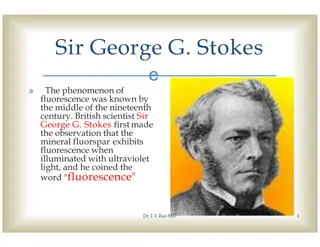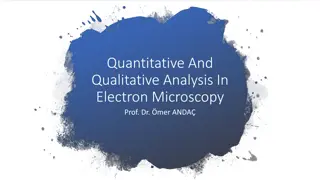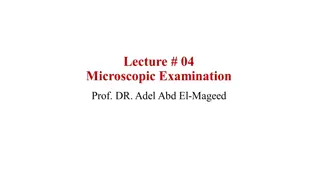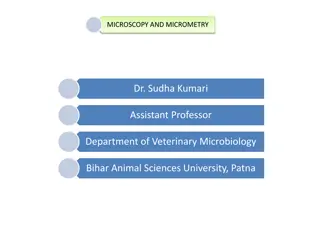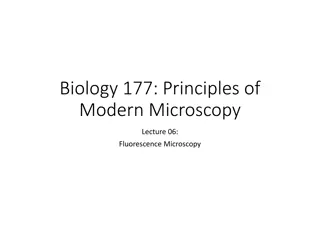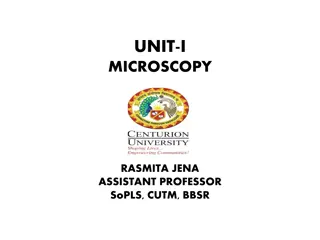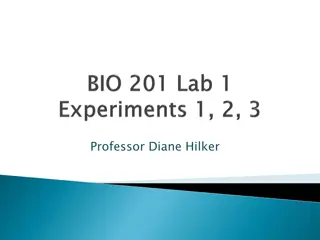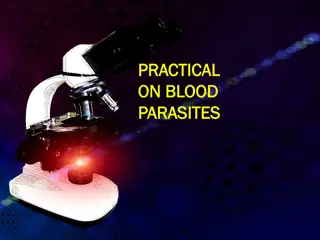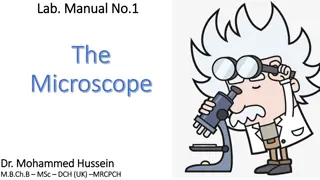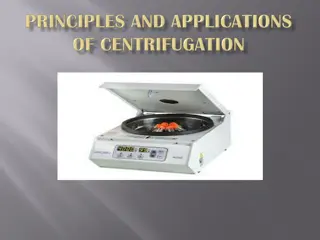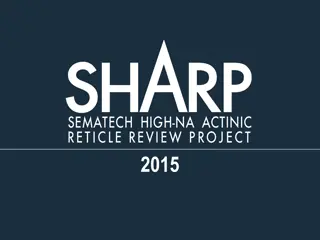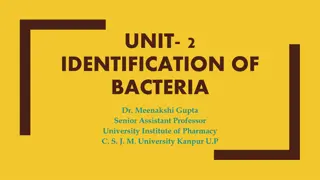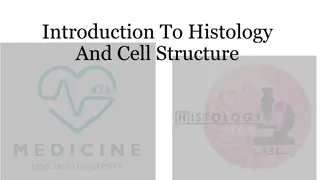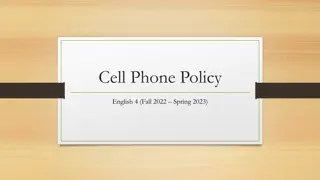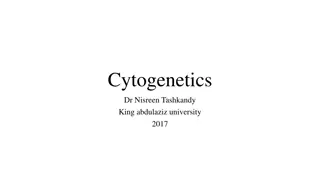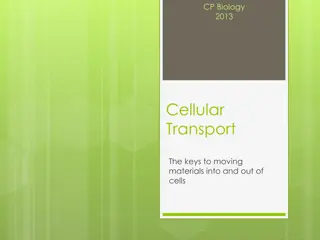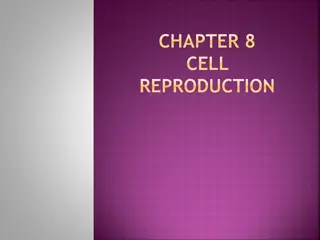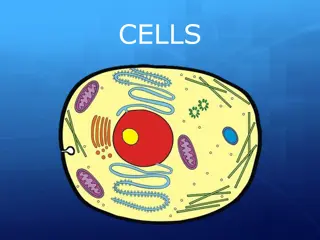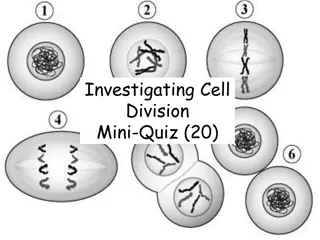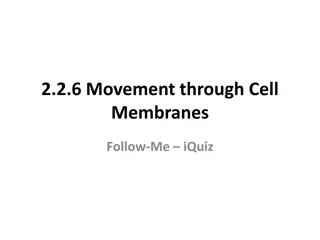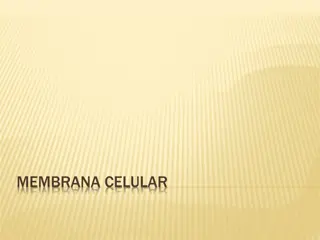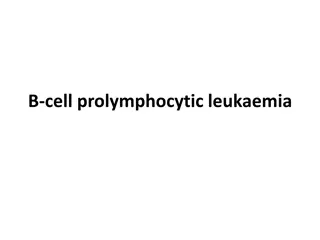Understanding Cell Structure and Microscopy
Explore the world of cell biology and microscopy through a quiz covering topics such as cell structure, iodine use in the laboratory, magnification in microscopes, and more. Test your knowledge and learn about crucial aspects of cellular biology in an interactive format.
Download Presentation

Please find below an Image/Link to download the presentation.
The content on the website is provided AS IS for your information and personal use only. It may not be sold, licensed, or shared on other websites without obtaining consent from the author. Download presentation by click this link. If you encounter any issues during the download, it is possible that the publisher has removed the file from their server.
E N D
Presentation Transcript
2.1 Cell Structure & Microscopy 1 Follow-Me iQuiz
Q. State a use for iodine in the biology laboratory. 200 Protein synthesis 200 Protein synthesis Eukaryotic Eukaryotic 300 Sap; Water; Glucose 300 Sap; Water; Glucose FALSE FALSE Allows some molecules through Selectively permeable Allows some molecules through Selectively permeable Membrane Membrane Starch detection; Staining cells Cell membrane Starch detection; Staining cells Cell membrane Methylene blue Methylene blue Cell wall; Chloroplasts; Large vacuoles; Starch granules; Shape To examine a specimen; Protect lens; Reduce evaporation; Hold specimen in place To examine a specimen; Protect lens; Reduce evaporation; Hold specimen in place Cell wall; Chloroplasts; Large vacuoles; Starch granules; Shape Mitochondrion Mitochondrion Cell wall; Vacuole; Chloroplast; Definite shape TRUE Cell wall; Vacuole; Chloroplast; Definite shape TRUE Nucleus, Membrane-bound organelles Nucleus, Membrane- bound organelles Cellulose Vacuole Cellulose Vacuole Prokaryotic Prokaryotic Electron microscope Water; Cytoplasm Electron microscope Water; Cytoplasm
CONGRATULATIONS Please CLICK on THIS BOX for the Next Question Please CLICK on THIS BOX for the Next Question
Q. A microscope has an eyepiece lens marked 10 and an objective lens marked 20. What is the total magnification of the image? 200 Protein synthesis 200 Protein synthesis Eukaryotic Eukaryotic 300 Sap; Water; Glucose 300 Sap; Water; Glucose FALSE FALSE Allows some molecules through Selectively permeable Allows some molecules through Selectively permeable Membrane Membrane Starch detection; Staining cells Cell membrane Starch detection; Staining cells Cell membrane Methylene blue Methylene blue Cell wall; Chloroplasts; Large vacuoles; Starch granules; Shape To examine a specimen; Protect lens; Reduce evaporation; Hold specimen in place To examine a specimen; Protect lens; Reduce evaporation; Hold specimen in place Cell wall; Chloroplasts; Large vacuoles; Starch granules; Shape Mitochondrion Mitochondrion Cell wall; Vacuole; Chloroplast; Definite shape TRUE Cell wall; Vacuole; Chloroplast; Definite shape TRUE Nucleus, Membrane-bound organelles Nucleus, Membrane- bound organelles Cellulose Vacuole Cellulose Vacuole Prokaryotic Prokaryotic Electron microscope Water; Cytoplasm Electron microscope Water; Cytoplasm
CONGRATULATIONS Please CLICK on THIS BOX for the Next Question Please CLICK on THIS BOX for the Next Question
Q. Name a powerful type of microscope that is used to show cell ultrastructure. 200 Protein synthesis 200 Protein synthesis Eukaryotic Eukaryotic 300 Sap; Water; Glucose 300 Sap; Water; Glucose FALSE FALSE Allows some molecules through Selectively permeable Allows some molecules through Selectively permeable Membrane Membrane Starch detection; Staining cells Cell membrane Starch detection; Staining cells Cell membrane Methylene blue Methylene blue Cell wall; Chloroplasts; Large vacuoles; Starch granules; Shape To examine a specimen; Protect lens; Reduce evaporation; Hold specimen in place To examine a specimen; Protect lens; Reduce evaporation; Hold specimen in place Cell wall; Chloroplasts; Large vacuoles; Starch granules; Shape Mitochondrion Mitochondrion Cell wall; Vacuole; Chloroplast; Definite shape TRUE Cell wall; Vacuole; Chloroplast; Definite shape TRUE Nucleus, Membrane-bound organelles Nucleus, Membrane- bound organelles Cellulose Vacuole Cellulose Vacuole Prokaryotic Prokaryotic Electron microscope Water; Cytoplasm Electron microscope Water; Cytoplasm
CONGRATULATIONS Please CLICK on THIS BOX for the Next Question Please CLICK on THIS BOX for the Next Question
Q. True or False. If the eyepiece lens of a microscope is marked X10 and the objective lens is marked X3, the total magnification is X13. 200 Protein synthesis 200 Protein synthesis Eukaryotic Eukaryotic 300 Sap; Water; Glucose 300 Sap; Water; Glucose FALSE FALSE Allows some molecules through Selectively permeable Allows some molecules through Selectively permeable Membrane Membrane Starch detection; Staining cells Cell membrane Starch detection; Staining cells Cell membrane Methylene blue Methylene blue Cell wall; Chloroplasts; Large vacuoles; Starch granules; Shape To examine a specimen; Protect lens; Reduce evaporation; Hold specimen in place To examine a specimen; Protect lens; Reduce evaporation; Hold specimen in place Cell wall; Chloroplasts; Large vacuoles; Starch granules; Shape Mitochondrion Mitochondrion Cell wall; Vacuole; Chloroplast; Definite shape TRUE Cell wall; Vacuole; Chloroplast; Definite shape TRUE Nucleus, Membrane-bound organelles Nucleus, Membrane- bound organelles Cellulose Vacuole Cellulose Vacuole Prokaryotic Prokaryotic Electron microscope Water; Cytoplasm Electron microscope Water; Cytoplasm
CONGRATULATIONS Please CLICK on THIS BOX for the Next Question Please CLICK on THIS BOX for the Next Question
Q. If the magnification of the eyepiece of a microscope is X 10 and the magnification of the objective lens is X 30, what magnification results when a slide is viewed? 200 Protein synthesis 200 Protein synthesis Eukaryotic Eukaryotic 300 Sap; Water; Glucose 300 Sap; Water; Glucose FALSE FALSE Allows some molecules through Selectively permeable Allows some molecules through Selectively permeable Membrane Membrane Starch detection; Staining cells Cell membrane Starch detection; Staining cells Cell membrane Methylene blue Methylene blue Cell wall; Chloroplasts; Large vacuoles; Starch granules; Shape To examine a specimen; Protect lens; Reduce evaporation; Hold specimen in place To examine a specimen; Protect lens; Reduce evaporation; Hold specimen in place Cell wall; Chloroplasts; Large vacuoles; Starch granules; Shape Mitochondrion Mitochondrion Cell wall; Vacuole; Chloroplast; Definite shape TRUE Cell wall; Vacuole; Chloroplast; Definite shape TRUE Nucleus, Membrane-bound organelles Nucleus, Membrane- bound organelles Cellulose Vacuole Cellulose Vacuole Prokaryotic Prokaryotic Electron microscope Water; Cytoplasm Electron microscope Water; Cytoplasm
CONGRATULATIONS Please CLICK on THIS BOX for the Next Question Please CLICK on THIS BOX for the Next Question
Q. For what purpose did you use a Cover slip in the course of your practical activities? 200 Protein synthesis 200 Protein synthesis Eukaryotic Eukaryotic 300 Sap; Water; Glucose 300 Sap; Water; Glucose FALSE FALSE Allows some molecules through Selectively permeable Allows some molecules through Selectively permeable Membrane Membrane Starch detection; Staining cells Cell membrane Starch detection; Staining cells Cell membrane Methylene blue Methylene blue Cell wall; Chloroplasts; Large vacuoles; Starch granules; Shape To examine a specimen; Protect lens; Reduce evaporation; Hold specimen in place To examine a specimen; Protect lens; Reduce evaporation; Hold specimen in place Cell wall; Chloroplasts; Large vacuoles; Starch granules; Shape Mitochondrion Mitochondrion Cell wall; Vacuole; Chloroplast; Definite shape TRUE Cell wall; Vacuole; Chloroplast; Definite shape TRUE Nucleus, Membrane-bound organelles Nucleus, Membrane- bound organelles Cellulose Vacuole Cellulose Vacuole Prokaryotic Prokaryotic Electron microscope Water; Cytoplasm Electron microscope Water; Cytoplasm
CONGRATULATIONS Please CLICK on THIS BOX for the Next Question Please CLICK on THIS BOX for the Next Question
Q. True or False. The microscope lenses closest to the stage are the eyepiece lenses. 200 Protein synthesis 200 Protein synthesis Eukaryotic Eukaryotic 300 Sap; Water; Glucose 300 Sap; Water; Glucose FALSE FALSE Allows some molecules through Selectively permeable Allows some molecules through Selectively permeable Membrane Membrane Starch detection; Staining cells Cell membrane Starch detection; Staining cells Cell membrane Methylene blue Methylene blue Cell wall; Chloroplasts; Large vacuoles; Starch granules; Shape To examine a specimen; Protect lens; Reduce evaporation; Hold specimen in place To examine a specimen; Protect lens; Reduce evaporation; Hold specimen in place Cell wall; Chloroplasts; Large vacuoles; Starch granules; Shape Mitochondrion Mitochondrion Cell wall; Vacuole; Chloroplast; Definite shape TRUE Cell wall; Vacuole; Chloroplast; Definite shape TRUE Nucleus, Membrane-bound organelles Nucleus, Membrane- bound organelles Cellulose Vacuole Cellulose Vacuole Prokaryotic Prokaryotic Electron microscope Water; Cytoplasm Electron microscope Water; Cytoplasm
CONGRATULATIONS Please CLICK on THIS BOX for the Next Question Please CLICK on THIS BOX for the Next Question
Q. Where in a cell would you expect to find phospholipids? 200 Protein synthesis 200 Protein synthesis Eukaryotic Eukaryotic 300 Sap; Water; Glucose 300 Sap; Water; Glucose FALSE FALSE Allows some molecules through Selectively permeable Allows some molecules through Selectively permeable Membrane Membrane Starch detection; Staining cells Cell membrane Starch detection; Staining cells Cell membrane Methylene blue Methylene blue Cell wall; Chloroplasts; Large vacuoles; Starch granules; Shape To examine a specimen; Protect lens; Reduce evaporation; Hold specimen in place To examine a specimen; Protect lens; Reduce evaporation; Hold specimen in place Cell wall; Chloroplasts; Large vacuoles; Starch granules; Shape Mitochondrion Mitochondrion Cell wall; Vacuole; Chloroplast; Definite shape TRUE Cell wall; Vacuole; Chloroplast; Definite shape TRUE Nucleus, Membrane-bound organelles Nucleus, Membrane- bound organelles Cellulose Vacuole Cellulose Vacuole Prokaryotic Prokaryotic Electron microscope Water; Cytoplasm Electron microscope Water; Cytoplasm
CONGRATULATIONS Please CLICK on THIS BOX for the Next Question Please CLICK on THIS BOX for the Next Question
Q. State a function of a Ribosome. 200 Protein synthesis 200 Protein synthesis Eukaryotic Eukaryotic 300 Sap; Water; Glucose 300 Sap; Water; Glucose FALSE FALSE Allows some molecules through Selectively permeable Allows some molecules through Selectively permeable Membrane Membrane Starch detection; Staining cells Cell membrane Starch detection; Staining cells Cell membrane Methylene blue Methylene blue Cell wall; Chloroplasts; Large vacuoles; Starch granules; Shape To examine a specimen; Protect lens; Reduce evaporation; Hold specimen in place To examine a specimen; Protect lens; Reduce evaporation; Hold specimen in place Cell wall; Chloroplasts; Large vacuoles; Starch granules; Shape Mitochondrion Mitochondrion Cell wall; Vacuole; Chloroplast; Definite shape TRUE Cell wall; Vacuole; Chloroplast; Definite shape TRUE Nucleus, Membrane-bound organelles Nucleus, Membrane- bound organelles Cellulose Vacuole Cellulose Vacuole Prokaryotic Prokaryotic Electron microscope Water; Cytoplasm Electron microscope Water; Cytoplasm
CONGRATULATIONS Please CLICK on THIS BOX for the Next Question Please CLICK on THIS BOX for the Next Question
Q. State a function of the cell membrane. 200 Protein synthesis 200 Protein synthesis Eukaryotic Eukaryotic 300 Sap; Water; Glucose 300 Sap; Water; Glucose FALSE FALSE Allows some molecules through Selectively permeable Allows some molecules through Selectively permeable Membrane Membrane Starch detection; Staining cells Cell membrane Starch detection; Staining cells Cell membrane Methylene blue Methylene blue Cell wall; Chloroplasts; Large vacuoles; Starch granules; Shape To examine a specimen; Protect lens; Reduce evaporation; Hold specimen in place To examine a specimen; Protect lens; Reduce evaporation; Hold specimen in place Cell wall; Chloroplasts; Large vacuoles; Starch granules; Shape Mitochondrion Mitochondrion Cell wall; Vacuole; Chloroplast; Definite shape TRUE Cell wall; Vacuole; Chloroplast; Definite shape TRUE Nucleus, Membrane-bound organelles Nucleus, Membrane- bound organelles Cellulose Vacuole Cellulose Vacuole Prokaryotic Prokaryotic Electron microscope Water; Cytoplasm Electron microscope Water; Cytoplasm
CONGRATULATIONS Please CLICK on THIS BOX for the Next Question Please CLICK on THIS BOX for the Next Question
Q. When preparing an animal cell for examination under a microscope, name the stain that you used. 200 Protein synthesis 200 Protein synthesis Eukaryotic Eukaryotic 300 Sap; Water; Glucose 300 Sap; Water; Glucose FALSE FALSE Allows some molecules through Selectively permeable Allows some molecules through Selectively permeable Membrane Membrane Starch detection; Staining cells Cell membrane Starch detection; Staining cells Cell membrane Methylene blue Methylene blue Cell wall; Chloroplasts; Large vacuoles; Starch granules; Shape To examine a specimen; Protect lens; Reduce evaporation; Hold specimen in place To examine a specimen; Protect lens; Reduce evaporation; Hold specimen in place Cell wall; Chloroplasts; Large vacuoles; Starch granules; Shape Mitochondrion Mitochondrion Cell wall; Vacuole; Chloroplast; Definite shape TRUE Cell wall; Vacuole; Chloroplast; Definite shape TRUE Nucleus, Membrane-bound organelles Nucleus, Membrane- bound organelles Cellulose Vacuole Cellulose Vacuole Prokaryotic Prokaryotic Electron microscope Water; Cytoplasm Electron microscope Water; Cytoplasm
CONGRATULATIONS Please CLICK on THIS BOX for the Next Question Please CLICK on THIS BOX for the Next Question
Q. Give two characteristic features of eukaryotic cells. 200 Protein synthesis 200 Protein synthesis Eukaryotic Eukaryotic 300 Sap; Water; Glucose 300 Sap; Water; Glucose FALSE FALSE Allows some molecules through Selectively permeable Allows some molecules through Selectively permeable Membrane Membrane Starch detection; Staining cells Cell membrane Starch detection; Staining cells Cell membrane Methylene blue Methylene blue Cell wall; Chloroplasts; Large vacuoles; Starch granules; Shape To examine a specimen; Protect lens; Reduce evaporation; Hold specimen in place To examine a specimen; Protect lens; Reduce evaporation; Hold specimen in place Cell wall; Chloroplasts; Large vacuoles; Starch granules; Shape Mitochondrion Mitochondrion Cell wall; Vacuole; Chloroplast; Definite shape TRUE Cell wall; Vacuole; Chloroplast; Definite shape TRUE Nucleus, Membrane-bound organelles Nucleus, Membrane- bound organelles Cellulose Vacuole Cellulose Vacuole Prokaryotic Prokaryotic Electron microscope Water; Cytoplasm Electron microscope Water; Cytoplasm
CONGRATULATIONS Please CLICK on THIS BOX for the Next Question Please CLICK on THIS BOX for the Next Question
Q. What term is used to describe bacterial cells? 200 Protein synthesis 200 Protein synthesis Eukaryotic Eukaryotic 300 Sap; Water; Glucose 300 Sap; Water; Glucose FALSE FALSE Allows some molecules through Selectively permeable Allows some molecules through Selectively permeable Membrane Membrane Starch detection; Staining cells Cell membrane Starch detection; Staining cells Cell membrane Methylene blue Methylene blue Cell wall; Chloroplasts; Large vacuoles; Starch granules; Shape To examine a specimen; Protect lens; Reduce evaporation; Hold specimen in place To examine a specimen; Protect lens; Reduce evaporation; Hold specimen in place Cell wall; Chloroplasts; Large vacuoles; Starch granules; Shape Mitochondrion Mitochondrion Cell wall; Vacuole; Chloroplast; Definite shape TRUE Cell wall; Vacuole; Chloroplast; Definite shape TRUE Nucleus, Membrane-bound organelles Nucleus, Membrane- bound organelles Cellulose Vacuole Cellulose Vacuole Prokaryotic Prokaryotic Electron microscope Water; Cytoplasm Electron microscope Water; Cytoplasm
CONGRATULATIONS Please CLICK on THIS BOX for the Next Question Please CLICK on THIS BOX for the Next Question
Q. State two features of plant cells visible under a light microscope that indicate that they are typical plant cells. 200 Protein synthesis 200 Protein synthesis Eukaryotic Eukaryotic 300 Sap; Water; Glucose 300 Sap; Water; Glucose FALSE FALSE Allows some molecules through Selectively permeable Allows some molecules through Selectively permeable Membrane Membrane Starch detection; Staining cells Cell membrane Starch detection; Staining cells Cell membrane Methylene blue Methylene blue Cell wall; Chloroplasts; Large vacuoles; Starch granules; Shape To examine a specimen; Protect lens; Reduce evaporation; Hold specimen in place To examine a specimen; Protect lens; Reduce evaporation; Hold specimen in place Cell wall; Chloroplasts; Large vacuoles; Starch granules; Shape Mitochondrion Mitochondrion Cell wall; Vacuole; Chloroplast; Definite shape TRUE Cell wall; Vacuole; Chloroplast; Definite shape TRUE Nucleus, Membrane-bound organelles Nucleus, Membrane- bound organelles Cellulose Vacuole Cellulose Vacuole Prokaryotic Prokaryotic Electron microscope Water; Cytoplasm Electron microscope Water; Cytoplasm
CONGRATULATIONS Please CLICK on THIS BOX for the Next Question Please CLICK on THIS BOX for the Next Question
Q. What cellular organelle is the site of energy release? 200 Protein synthesis 200 Protein synthesis Eukaryotic Eukaryotic 300 Sap; Water; Glucose 300 Sap; Water; Glucose FALSE FALSE Allows some molecules through Selectively permeable Allows some molecules through Selectively permeable Membrane Membrane Starch detection; Staining cells Cell membrane Starch detection; Staining cells Cell membrane Methylene blue Methylene blue Cell wall; Chloroplasts; Large vacuoles; Starch granules; Shape To examine a specimen; Protect lens; Reduce evaporation; Hold specimen in place To examine a specimen; Protect lens; Reduce evaporation; Hold specimen in place Cell wall; Chloroplasts; Large vacuoles; Starch granules; Shape Mitochondrion Mitochondrion Cell wall; Vacuole; Chloroplast; Definite shape TRUE Cell wall; Vacuole; Chloroplast; Definite shape TRUE Nucleus, Membrane-bound organelles Nucleus, Membrane- bound organelles Cellulose Vacuole Cellulose Vacuole Prokaryotic Prokaryotic Electron microscope Water; Cytoplasm Electron microscope Water; Cytoplasm
CONGRATULATIONS Please CLICK on THIS BOX for the Next Question Please CLICK on THIS BOX for the Next Question
Q. What cellular organelle is the site of water storage? 200 Protein synthesis 200 Protein synthesis Eukaryotic Eukaryotic 300 Sap; Water; Glucose 300 Sap; Water; Glucose FALSE FALSE Allows some molecules through Selectively permeable Allows some molecules through Selectively permeable Membrane Membrane Starch detection; Staining cells Cell membrane Starch detection; Staining cells Cell membrane Methylene blue Methylene blue Cell wall; Chloroplasts; Large vacuoles; Starch granules; Shape To examine a specimen; Protect lens; Reduce evaporation; Hold specimen in place To examine a specimen; Protect lens; Reduce evaporation; Hold specimen in place Cell wall; Chloroplasts; Large vacuoles; Starch granules; Shape Mitochondrion Mitochondrion Cell wall; Vacuole; Chloroplast; Definite shape TRUE Cell wall; Vacuole; Chloroplast; Definite shape TRUE Nucleus, Membrane-bound organelles Nucleus, Membrane- bound organelles Cellulose Vacuole Cellulose Vacuole Prokaryotic Prokaryotic Electron microscope Water; Cytoplasm Electron microscope Water; Cytoplasm
CONGRATULATIONS Please CLICK on THIS BOX for the Next Question Please CLICK on THIS BOX for the Next Question
Q. Is the cell of Amoeba prokaryotic or eukaryotic? 200 Protein synthesis 200 Protein synthesis Eukaryotic Eukaryotic 300 Sap; Water; Glucose 300 Sap; Water; Glucose FALSE FALSE Allows some molecules through Selectively permeable Allows some molecules through Selectively permeable Membrane Membrane Starch detection; Staining cells Cell membrane Starch detection; Staining cells Cell membrane Methylene blue Methylene blue Cell wall; Chloroplasts; Large vacuoles; Starch granules; Shape To examine a specimen; Protect lens; Reduce evaporation; Hold specimen in place To examine a specimen; Protect lens; Reduce evaporation; Hold specimen in place Cell wall; Chloroplasts; Large vacuoles; Starch granules; Shape Mitochondrion Mitochondrion Cell wall; Vacuole; Chloroplast; Definite shape TRUE Cell wall; Vacuole; Chloroplast; Definite shape TRUE Nucleus, Membrane-bound organelles Nucleus, Membrane- bound organelles Cellulose Vacuole Cellulose Vacuole Prokaryotic Prokaryotic Electron microscope Water; Cytoplasm Electron microscope Water; Cytoplasm
CONGRATULATIONS Please CLICK on THIS BOX for the Next Question Please CLICK on THIS BOX for the Next Question
Q. What component of a cell allows osmosis to occur? 200 Protein synthesis 200 Protein synthesis Eukaryotic Eukaryotic 300 Sap; Water; Glucose 300 Sap; Water; Glucose FALSE FALSE Allows some molecules through Selectively permeable Allows some molecules through Selectively permeable Membrane Membrane Starch detection; Staining cells Cell membrane Starch detection; Staining cells Cell membrane Methylene blue Methylene blue Cell wall; Chloroplasts; Large vacuoles; Starch granules; Shape To examine a specimen; Protect lens; Reduce evaporation; Hold specimen in place To examine a specimen; Protect lens; Reduce evaporation; Hold specimen in place Cell wall; Chloroplasts; Large vacuoles; Starch granules; Shape Mitochondrion Mitochondrion Cell wall; Vacuole; Chloroplast; Definite shape TRUE Cell wall; Vacuole; Chloroplast; Definite shape TRUE Nucleus, Membrane-bound organelles Nucleus, Membrane- bound organelles Cellulose Vacuole Cellulose Vacuole Prokaryotic Prokaryotic Electron microscope Water; Cytoplasm Electron microscope Water; Cytoplasm
CONGRATULATIONS Please CLICK on THIS BOX for the Next Question Please CLICK on THIS BOX for the Next Question
Q. What is a selectively permeable (semi-permeable) membrane? 200 Protein synthesis 200 Protein synthesis Eukaryotic Eukaryotic 300 Sap; Water; Glucose 300 Sap; Water; Glucose FALSE FALSE Allows some molecules through Selectively permeable Allows some molecules through Selectively permeable Membrane Membrane Starch detection; Staining cells Cell membrane Starch detection; Staining cells Cell membrane Methylene blue Methylene blue Cell wall; Chloroplasts; Large vacuoles; Starch granules; Shape To examine a specimen; Protect lens; Reduce evaporation; Hold specimen in place To examine a specimen; Protect lens; Reduce evaporation; Hold specimen in place Cell wall; Chloroplasts; Large vacuoles; Starch granules; Shape Mitochondrion Mitochondrion Cell wall; Vacuole; Chloroplast; Definite shape TRUE Cell wall; Vacuole; Chloroplast; Definite shape TRUE Nucleus, Membrane-bound organelles Nucleus, Membrane- bound organelles Cellulose Vacuole Cellulose Vacuole Prokaryotic Prokaryotic Electron microscope Water; Cytoplasm Electron microscope Water; Cytoplasm
CONGRATULATIONS Please CLICK on THIS BOX for the Next Question Please CLICK on THIS BOX for the Next Question
Q. Name two features of a plant cell which are not normally associated with an animal cell. 200 Protein synthesis 200 Protein synthesis Eukaryotic Eukaryotic 300 Sap; Water; Glucose 300 Sap; Water; Glucose FALSE FALSE Allows some molecules through Selectively permeable Allows some molecules through Selectively permeable Membrane Membrane Starch detection; Staining cells Cell membrane Starch detection; Staining cells Cell membrane Methylene blue Methylene blue Cell wall; Chloroplasts; Large vacuoles; Starch granules; Shape To examine a specimen; Protect lens; Reduce evaporation; Hold specimen in place To examine a specimen; Protect lens; Reduce evaporation; Hold specimen in place Cell wall; Chloroplasts; Large vacuoles; Starch granules; Shape Mitochondrion Mitochondrion Cell wall; Vacuole; Chloroplast; Definite shape TRUE Cell wall; Vacuole; Chloroplast; Definite shape TRUE Nucleus, Membrane-bound organelles Nucleus, Membrane- bound organelles Cellulose Vacuole Cellulose Vacuole Prokaryotic Prokaryotic Electron microscope Water; Cytoplasm Electron microscope Water; Cytoplasm
CONGRATULATIONS Please CLICK on THIS BOX for the Next Question Please CLICK on THIS BOX for the Next Question
Q. What is usually found in the vacuole? 200 Protein synthesis 200 Protein synthesis Eukaryotic Eukaryotic 300 Sap; Water; Glucose 300 Sap; Water; Glucose FALSE FALSE Allows some molecules through Selectively permeable Allows some molecules through Selectively permeable Membrane Membrane Starch detection; Staining cells Cell membrane Starch detection; Staining cells Cell membrane Methylene blue Methylene blue Cell wall; Chloroplasts; Large vacuoles; Starch granules; Shape To examine a specimen; Protect lens; Reduce evaporation; Hold specimen in place To examine a specimen; Protect lens; Reduce evaporation; Hold specimen in place Cell wall; Chloroplasts; Large vacuoles; Starch granules; Shape Mitochondrion Mitochondrion Cell wall; Vacuole; Chloroplast; Definite shape TRUE Cell wall; Vacuole; Chloroplast; Definite shape TRUE Nucleus, Membrane-bound organelles Nucleus, Membrane- bound organelles Cellulose Vacuole Cellulose Vacuole Prokaryotic Prokaryotic Electron microscope Water; Cytoplasm Electron microscope Water; Cytoplasm
CONGRATULATIONS Please CLICK on THIS BOX for the Next Question Please CLICK on THIS BOX for the Next Question
Q. Name a carbohydrate found in the cell wall. 200 Protein synthesis 200 Protein synthesis Eukaryotic Eukaryotic 300 Sap; Water; Glucose 300 Sap; Water; Glucose FALSE FALSE Allows some molecules through Selectively permeable Allows some molecules through Selectively permeable Membrane Membrane Starch detection; Staining cells Cell membrane Starch detection; Staining cells Cell membrane Methylene blue Methylene blue Cell wall; Chloroplasts; Large vacuoles; Starch granules; Shape To examine a specimen; Protect lens; Reduce evaporation; Hold specimen in place To examine a specimen; Protect lens; Reduce evaporation; Hold specimen in place Cell wall; Chloroplasts; Large vacuoles; Starch granules; Shape Mitochondrion Mitochondrion Cell wall; Vacuole; Chloroplast; Definite shape TRUE Cell wall; Vacuole; Chloroplast; Definite shape TRUE Nucleus, Membrane-bound organelles Nucleus, Membrane- bound organelles Cellulose Vacuole Cellulose Vacuole Prokaryotic Prokaryotic Electron microscope Water; Cytoplasm Electron microscope Water; Cytoplasm
CONGRATULATIONS Please CLICK on THIS BOX for the Next Question Please CLICK on THIS BOX for the Next Question
Q. The liquid in which chemical reactions take place in the cell is 200 Protein synthesis 200 Protein synthesis Eukaryotic Eukaryotic 300 Sap; Water; Glucose 300 Sap; Water; Glucose FALSE FALSE Allows some molecules through Selectively permeable Allows some molecules through Selectively permeable Membrane Membrane Starch detection; Staining cells Cell membrane Starch detection; Staining cells Cell membrane Methylene blue Methylene blue Cell wall; Chloroplasts; Large vacuoles; Starch granules; Shape To examine a specimen; Protect lens; Reduce evaporation; Hold specimen in place To examine a specimen; Protect lens; Reduce evaporation; Hold specimen in place Cell wall; Chloroplasts; Large vacuoles; Starch granules; Shape Mitochondrion Mitochondrion Cell wall; Vacuole; Chloroplast; Definite shape TRUE Cell wall; Vacuole; Chloroplast; Definite shape TRUE Nucleus, Membrane-bound organelles Nucleus, Membrane- bound organelles Cellulose Vacuole Cellulose Vacuole Prokaryotic Prokaryotic Electron microscope Water; Cytoplasm Electron microscope Water; Cytoplasm
CONGRATULATIONS Please CLICK on THIS BOX for the Next Question Please CLICK on THIS BOX for the Next Question
Q. True or False. Plant cells have chloroplasts; animal cells do not have chloroplasts. 200 Protein synthesis 200 Protein synthesis Eukaryotic Eukaryotic 300 Sap; Water; Glucose 300 Sap; Water; Glucose FALSE FALSE Allows some molecules through Selectively permeable Allows some molecules through Selectively permeable Membrane Membrane Starch detection; Staining cells Cell membrane Starch detection; Staining cells Cell membrane Methylene blue Methylene blue Cell wall; Chloroplasts; Large vacuoles; Starch granules; Shape To examine a specimen; Protect lens; Reduce evaporation; Hold specimen in place To examine a specimen; Protect lens; Reduce evaporation; Hold specimen in place Cell wall; Chloroplasts; Large vacuoles; Starch granules; Shape Mitochondrion Mitochondrion Cell wall; Vacuole; Chloroplast; Definite shape TRUE Cell wall; Vacuole; Chloroplast; Definite shape TRUE Nucleus, Membrane-bound organelles Nucleus, Membrane- bound organelles Cellulose Vacuole Cellulose Vacuole Prokaryotic Prokaryotic Electron microscope Water; Cytoplasm Electron microscope Water; Cytoplasm
CONGRATULATIONS You re Brilliant
Incorrect Please CLICK on THIS BOX to Try Again Please CLICK on THIS BOX to Try Again


